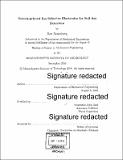| dc.contributor.advisor | Anastasios John Hart. | en_US |
| dc.contributor.author | Rosenberg, Ron, S.M. Massachusetts Institute of Technology | en_US |
| dc.contributor.other | Massachusetts Institute of Technology. Department of Mechanical Engineering. | en_US |
| dc.date.accessioned | 2017-08-01T13:14:27Z | |
| dc.date.available | 2017-08-01T13:14:27Z | |
| dc.date.copyright | 2016 | en_US |
| dc.date.issued | 2016 | en_US |
| dc.identifier.uri | http://hdl.handle.net/1721.1/110884 | |
| dc.description | Thesis: S.M., Massachusetts Institute of Technology, Department of Mechanical Engineering, 2016. | en_US |
| dc.description | Cataloged from PDF version of thesis. | en_US |
| dc.description | Includes bibliographical references (pages 187-192). | en_US |
| dc.description.abstract | Rural Indian farmers lack an available, affordable, usable, and actionable means to diagnose soil health, which is a prerequisite for judicious application of fertilizer. Although government labs and mobile kits are available, these fail to meet the aforementioned qualities; as a result fewer than 5% of rural Indian farmers have ever performed a soil test. This thesis details the design and characterization of a point-of- use soil testing device, comprising a set of disposable ion-selective electrode (ISE) strips and a handheld electrochemical reader, which together transduce soil analyte concentrations into a numeric input for a mobile-phone based fertilizer recommendation engine. As a proof-of-concept, potassium (K+) selective electrodes are studied, because K+ is essential to plant growth and reproduction. The strips employ a simple two electrode system, wherein carbon nanotube and silver chloride inks are the electrode contacts, plasticizer-free butyl acrylate ion selective membranes are located on the working electrodes, and sodium-chloride doped polyvinyl butyral membranes provide stable reference potentials. The electrodes were fabricated by a combined screen printing and drop casting process, and the protocol, extraction solution, and reference potential stability were tuned to maximize ISE performance and repeatability. Using a mathematical model and supporting experiments, we verified that hydrogen selectivity determines the detection limit, and furthermore, that scientists can tune the ionophore-ionic site ratio to minimize this effect. Using the final electrode fabrication process, a set of 20 full ISE devices in the presence of 0.02M SrCl2 extraction solution were shown to have sub-uM detection limits and near-Nernstian average sensitivity (61 mV/decade). When compared to ICP data for a set of 30 soil samples using the final reader, the sensors demonstrated a 0.898 correlation factor. Workshops in India were conducted to determine user needs and corresponding product attributes, as well as a "usability index" for the system assessed across farmer demographics. The favorable system performance proves that solid-state ISEs are a promising technology for soil diagnostics in resource-constrained environments. | en_US |
| dc.description.statementofresponsibility | by Ron Rosenberg. | en_US |
| dc.format.extent | 192 pages | en_US |
| dc.language.iso | eng | en_US |
| dc.publisher | Massachusetts Institute of Technology | en_US |
| dc.rights | MIT theses are protected by copyright. They may be viewed, downloaded, or printed from this source but further reproduction or distribution in any format is prohibited without written permission. | en_US |
| dc.rights.uri | http://dspace.mit.edu/handle/1721.1/7582 | en_US |
| dc.subject | Mechanical Engineering. | en_US |
| dc.title | Screen-printed ion selective electrodes for soil ion detection | en_US |
| dc.type | Thesis | en_US |
| dc.description.degree | S.M. | en_US |
| dc.contributor.department | Massachusetts Institute of Technology. Department of Mechanical Engineering | |
| dc.identifier.oclc | 994207801 | en_US |
